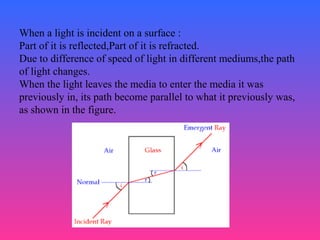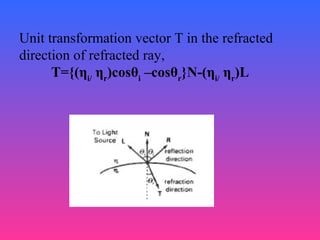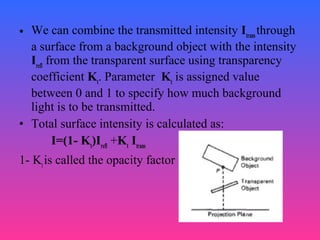The document describes the Phong shading model for modeling specular reflections. It explains that specular reflection results from total or near-total reflection of incident light in a concentrated region around the specular reflection angle. The Phong model sets the intensity of specular reflection proportional to the cosine of the viewing angle raised to a power 'n'. Higher values of 'n' produce shinier surfaces, while lower values produce duller surfaces. The model calculates specular reflection based on vectors representing the light source, viewer, and specular reflection direction.
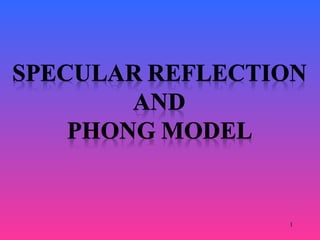













![15
Combine Diffuse & Specular
Reflections with Multiple Light
Sources
If we place more than one point source in a
scene, we obtain the light reflection at any
surface point by summing the contributions
from the individual sources:
I = ka
Ia
+ Σn
i=1
Ili
[kd
(N.
Li
) + ks
(N.
Hi
)ns
]](https://image.slidesharecdn.com/finalbhavyaayushi-170117180252/85/graphics-notes-15-320.jpg)
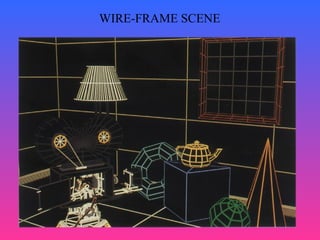

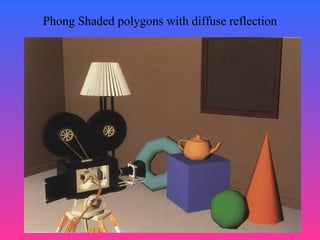





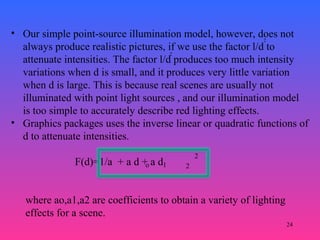
![25
• With a given set of attenuation coefficients , the magnitude of the
attenuation function can be limit to 1, as
F(d)=min(1,1/a + a d + a d )o 1 2
2
• Using this function , basis illumination model can be written
as:-
I = ka
Ia
+ Σn
i=1
f(d )Ili
[kd
(N.
Li
) + ks
(N.
Hi
)ns
]i
Where di is the distance , light has travelled from a light
source i.](https://image.slidesharecdn.com/finalbhavyaayushi-170117180252/85/graphics-notes-25-320.jpg)



![1.
• To set surface colors ,specify the reflectivity
coefficients vectors, for eg., diffuse reflection
would have k(dr),k(dg),k(db) components.
• For a blue surface,the intensity equation is :
• I = kab
Iab
+ Σn
i=1
f(d )Ilbi
[kdb
(N.
Li
) + ksb
(N.
Hi
)ns
]
• Here,k(dr)=k(dg)=0 ; k(db) has value in range 0 to
1.](https://image.slidesharecdn.com/finalbhavyaayushi-170117180252/85/graphics-notes-29-320.jpg)
![2.
• Another method for setting surface color is to specify the
components of diffuse and specular color vectors for each
surface ,without changes in reflectivity coefficients.
• For an RGB color representation the components of these two
surfaces color vector can be denoted as ( Sdr,
Sdg
,Sdb
) and (SSr
SSg
SSb
).the blue light component of reflected light is calculated as
:
• I = ka
Sdb
Iab
+ Σn
i=1
f(d )Ilbi
[kd
Sdb
(N.
Li
) + ks
SSb
(N.
Hi
)ns
]
• This approach is more flexible,since color parameters can be
set independently from reflectivity values.](https://image.slidesharecdn.com/finalbhavyaayushi-170117180252/85/graphics-notes-30-320.jpg)
![• We can simply represent any component of a color
specification with its spectral wavelength lambda
”λ”.
• Then,
• I = ka
Sdλ
Iaλ
+ Σn
i=1
f(d )Ilλi
[kd
Sdλ
(N.
Li
) + ks
SSλ
(N.
Hi
)ns
]
**spectral wavelength is the different wavelength
assigned to the various colours in the spectrum.**](https://image.slidesharecdn.com/finalbhavyaayushi-170117180252/85/graphics-notes-31-320.jpg)


